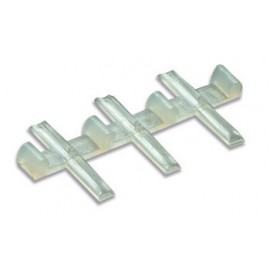You'll likely have come across the term "NEM pockets" when delving into the world of model railway couplers. But what...
No products
Product successfully added to your shopping cart
There are 0 items in your cart. There is 1 item in your cart.
Search Tips
What is the purpose of rail joiners?
Rail joiners, often referred to as fishplates, serve a critical role in ensuring the smooth operation of your layout. Their primary function is to connect two lengths of track, both physically and electrically, creating a continuous and reliable line for your trains to run on. Without these small yet essential components, you'd struggle to maintain consistent alignment or electrical flow between sections of track, which could result in derailments or intermittent power issues.
One of the key benefits of rail joiners is their ability to maintain electrical conductivity across your layout. Most model railway tracks are powered by a direct current (DC) or digital command control (DCC) system, where maintaining a reliable flow of electricity is crucial for smooth operation. Rail joiners ensure that current can pass seamlessly from one rail to the next, keeping your trains running without interruption. Even a tiny gap or misalignment can cause trains to lose power, which can be frustrating when you're in the middle of an operating session.
Physically, rail joiners also help to align the rails, preventing gaps that could lead to derailments. Track segments are rarely perfectly aligned by eye, especially over larger distances or in more complex track formations like curves or junctions. The joiners act as a guide, holding the ends of the rails together to ensure that the trains pass over the joints smoothly. Without them, small irregularities could cause the wheels to catch, leading to derailments or wear on both the track and rolling stock over time.
Rail joiners come in various materials, usually metal for conducting electricity, but some are made of insulating plastic. Plastic joiners are particularly useful in situations where you want to isolate sections of track for more complex wiring setups, such as creating isolated blocks in a DC layout or setting up reverse loops in a DCC system. Knowing when and where to use each type of joiner can significantly improve the performance and flexibility of your layout.
While they are small and often overlooked, maintaining your rail joiners is important. Over time, metal joiners can become loose or corroded, especially if your layout is exposed to humidity or changes in temperature. A poor connection can lead to unreliable running, so it's worth periodically checking and replacing them if needed. Some modellers even choose to solder the joiners to the track for a more permanent solution, although this makes future modifications more difficult.
In summary, rail joiners are a fundamental part of any model railway, playing a crucial role in both the physical and electrical integrity of your layout. Whether you're building a small shunting yard or a sprawling network, choosing the right joiners and maintaining them properly will help ensure that your trains run smoothly and reliably, giving you more time to enjoy the hobby without unnecessary disruptions.
Click here to receive the tips weekly in your mailbox. You can unsubscribe at any time.










